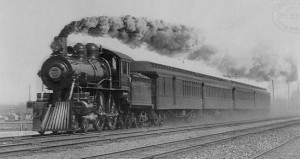Emile Jean Crapuchettes, he of the unfortunate surname and the precocious artistic talent, was born in 1889 and lived and created his whole life in Northern California, until his death in 1972. He’s not particularly well-known today, but seems to have been renowned in his time. Emile, the son of working-class parents, was a child prodigy who drew amazing chalk illustrations on the sidewalk outside of his family’s Bay Area laundromat. The San Francisco Call reported on the boy’s great talent when he was just four (and misspelled his last name, leaving off the “s”). The Brooklyn Daily Eagle subsequently reprinted the story on June 26, 1896, with the subtitle, “A Young San Francisco Boy Who Makes Remarkable Pictures.” An excerpt:
“The very latest California discovery in the way of infant prodigies is that of a 4 year old artist, who bids fair some day to rival the Gibsons, the Abbeys, the Vierges in the field of illustration. The work of the child wonder is the subject of no end of comment in the vicinity of his home, and the predictions as to his future are as numerous as the host of enthusiastic observers of his efforts, while the fame that is foreseen by all these ready made critics is of a variety as bright as the coals that keep the flatirons hot and as glowing as the polished shirt fronts to which the mother of the astonishing youngster has imparted the finishing touches in her little French laundry on Folsom street.
Mme. Crapuchette regards her little son Emile as a valuable assistant in affairs of her household; for, as young as he is, he is already quite competent to peel the potatoes, scrape the carrots, shell the peas and run errands in the neighborhood; but Mme. Crapuchette places no especial value on the artistic genius displayed by her precocious heir. In fact, Emile has often given offense by indulging his habit of scratching odd caricatures on the whitewashed walls, and ruining with his black pencil marks much good white paper which might otherwise be put to use in sending notices to forgetful patrons to the effect that there has been no recent diminution in the amount of their indebtedness. And then again, Emile covers the sidewalks with chalk figures that sweeping does not easily remove and that cause crowds to stop in front of the laundry door to talk foolishly about Emile being a ‘natural born artist.’
It has been remarked by the proprietress of the laundry that those people who halt and talk so much about the genius of the young Crapuchette never bring much work to the establishment, and, therefore, the madam would be quite as well pleased if they would go along about their business. The truth is that Emile’s parents do not take much stock in what strangers with busy tongues call ‘Emile’s gifts.’ Monsieur Crapuchette, it is very likely is looking forward to the day when his son Emile will be able to do much more than clean vegetables and run short errands–when that boy shall take his place on the delivery cart and exercise his wits in drumming up customers for the laundry. What a disappointment there will be when Emile, having grown old enough to drive the cart and solicit patronage, straightway washes his hands of the occupation by which his parents gained a livelihood. And then, how he will surprise those parents when he is earning handfuls of gold money for making pictures for the newspapers and the magazines.
Emile may be seen upon almost any sunny afternoon playing about the door of the laundry at 1,007 Folsom street. He goes bareheaded always, and is usually dressed in check apron and brown overalls. He isn’t beautiful, but is wonderfully bright. His brilliant brown eyes show keen intelligence. His complexion is light, and a rather flat nose mars the regularity of his features. When a Call man found him yesterday he was sketching a steam engine on the sidewalk, and near him was a box of colored crayons, with which some kindly interested and generous person had supplied him.
‘My boy, who showed you how to make the pictures of a steam engine?’ asked the newsgatherer.
‘No one showed me,’ answered the child, with a decidedly French accent. ‘I see it all the time go by.'”
Tags: Emile Jean Crapuchettes


